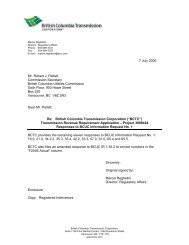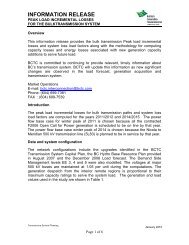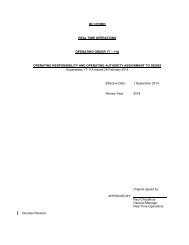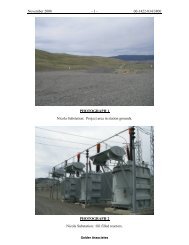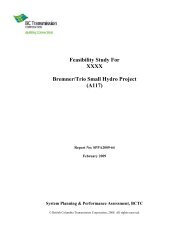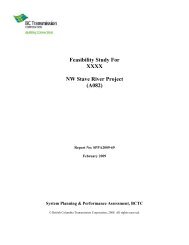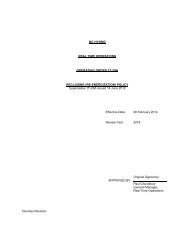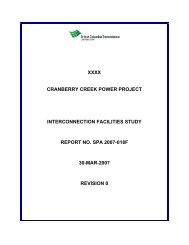Evidence on the Adequacy of First Nations Consultation - BC Hydro ...
Evidence on the Adequacy of First Nations Consultation - BC Hydro ...
Evidence on the Adequacy of First Nations Consultation - BC Hydro ...
You also want an ePaper? Increase the reach of your titles
YUMPU automatically turns print PDFs into web optimized ePapers that Google loves.
Salm<strong>on</strong> played an important part in <strong>the</strong> Kutenai ec<strong>on</strong>omy, but it is obvious that <strong>the</strong> members <strong>of</strong> <strong>the</strong> trout<br />
family were paramount in <strong>the</strong>ir thinking.<br />
The author indicates that <strong>the</strong> Upper Kootenay were c<strong>on</strong>sidered as very skilled at hook and line fishing<br />
but notes <strong>the</strong>y also practised small weir fishing <strong>of</strong> faster flowing waters using <strong>the</strong>ir distinctive c<strong>on</strong>ical<br />
traps in a funnel shape across <strong>the</strong> stream. Ano<strong>the</strong>r type <strong>of</strong> distinctive trap “was devised for use at<br />
waterfalls...[and] used in <strong>the</strong> autumn when <strong>the</strong> fish could be expected to be going down stream<br />
seeking deeper water” [p. 47].<br />
The Ktunaxa canoes were <strong>of</strong> <strong>the</strong> “sturge<strong>on</strong> nosed” type, with low pointed bow and sterns that were<br />
under <strong>the</strong> water, and designed primarily for paddling in lakes.<br />
A migrating Kutenai band could assemble a fleet <strong>of</strong> respectable size. Bull Robe [informant] says that<br />
he heard <strong>of</strong> an expediti<strong>on</strong> <strong>of</strong> <strong>the</strong> Libby-Jennings and Tobacco Plains bands travelling by river to<br />
Windermere in a fleet <strong>of</strong> <strong>on</strong>e hundred and fifty-five canoes.<br />
The seas<strong>on</strong>al round <strong>of</strong> <strong>the</strong> food quest is summarized in this way. Early in <strong>the</strong> spring <strong>the</strong> Ktunaxa<br />
went to <strong>the</strong>ir fishing grounds and in <strong>the</strong> late spring harvested roots. Then came <strong>the</strong> early summer<br />
bis<strong>on</strong> hunt, where <strong>the</strong>y were <strong>of</strong>ten joined by <strong>the</strong> Coeur d’Alene and Spokan Indians. This was<br />
followed by a general time <strong>of</strong> rest, especially for <strong>the</strong> horses, although women did lay in <strong>the</strong> annual<br />
berry supply. In <strong>the</strong> late summer, salm<strong>on</strong> fishing was a prominent activity, most notably in <strong>the</strong><br />
Windermere area, or westward towards Arrow Lakes. During <strong>the</strong> early autumn, <strong>the</strong> Lower Ktunaxa<br />
undertook <strong>the</strong>ir deer drives while <strong>the</strong> Upper Ktunaxa resumed hunting buffalo. Turney-High also<br />
menti<strong>on</strong>s that <strong>the</strong>re was a third buffalo hunt in <strong>the</strong> winter, but <strong>on</strong>e carried out by snow-shoe, not with<br />
riding and pack horses.<br />
Additi<strong>on</strong>ally, in <strong>the</strong> late summer, salm<strong>on</strong> fishing was a prominent activity, most notably in <strong>the</strong><br />
Windermere area, or westward towards Arrow Lakes.<br />
Although <strong>the</strong> buffalo hunt formed a central element in <strong>the</strong> Upper Ktunaxa way <strong>of</strong> life, Turney-High<br />
makes clear that <strong>the</strong> hunting <strong>of</strong> deer and bear and <strong>the</strong> fishing for bull trout and salm<strong>on</strong> were<br />
fundamentally important as well. He c<strong>on</strong>cludes his remarks <strong>on</strong> subsistence as follows [p. 55]:<br />
The Kutenai c<strong>on</strong>sidered <strong>the</strong>ir land a fortunate <strong>on</strong>e wherein any industrious man could get plenty to eat<br />
for himself and family. Scarcity, need, and famine were so unusual that <strong>the</strong>y were c<strong>on</strong>sidered <strong>of</strong><br />
supernatural origin.<br />
5. Bill Brunt<strong>on</strong><br />
Bill Brunt<strong>on</strong>’s views <strong>of</strong> <strong>the</strong> traditi<strong>on</strong>al territory <strong>of</strong> <strong>the</strong> Ktunaxa are found in Volume 12, Plateau, <strong>of</strong><br />
<strong>the</strong> Handbook <strong>of</strong> North American Indians, published by <strong>the</strong> Smiths<strong>on</strong>ian. The primary c<strong>on</strong>tributi<strong>on</strong><br />
taken from his article is his map at Fig. 6 entitled “Kootenai territory at c<strong>on</strong>tact in 1792…” and like<br />
Turney-High, he marks <strong>the</strong> nor<strong>the</strong>rn limit <strong>of</strong> Ktunaxa territory in <strong>the</strong> vicinity <strong>of</strong> Golden, B.C.<br />
Brunt<strong>on</strong>’s map [Figure 7] indicates a territorial divisi<strong>on</strong> between <strong>the</strong> Lower and Upper Kootenay that<br />
appears to follow <strong>the</strong> Purcell Range. Brunt<strong>on</strong>’s piece does not <strong>of</strong>fer much more for our specific<br />
purposes, although he notes that <strong>the</strong> first missi<strong>on</strong>ary establishment, named St. Mary’s and begun in<br />
archive], this fish was prized by Indians and settlers alike who would usually take it by hook and line ice fishing [see<br />
picture, p. 101].<br />
41<br />
Page 185 <strong>of</strong> 200






